-
28.10.2016
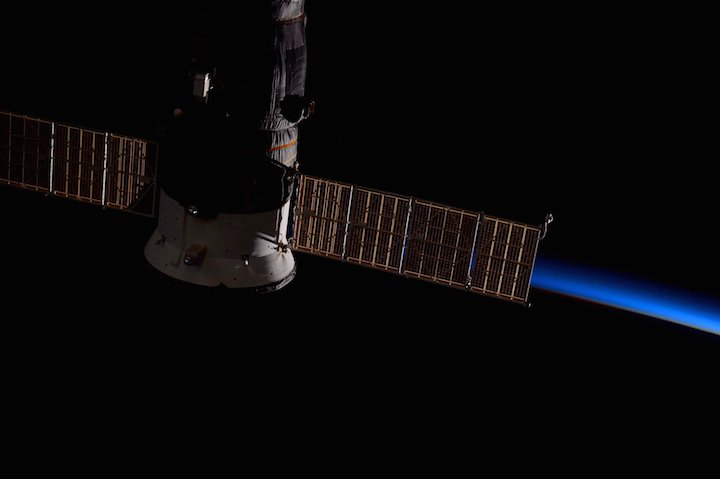
Ten seconds shy of midnight EDT on Saturday, 29 October, three spacefarers from three sovereign nations will return to Earth after almost four months aboard the International Space Station (ISS). Expedition 49 Commander Anatoli Ivanishin of Russia, together with NASA’s Kate Rubins and Japan Aerospace Exploration Agency (JAXA) astronaut Takuya Onishi, will have spent a little over 115 days in the microgravity environment, during which time they deftly supported hundreds of research experiments, oversaw the capture and berthing of two commercial visiting vehicles at the U.S. Orbital Segment (USOS), and supported a pair of long-overdue and critical EVAs. Tomorrow (Friday), Ivanishin will relinquish command of the space station to NASA astronaut Shane Kimbrough, who will lead Expedition 50 through late February 2017.
Ivanishin, Rubins, and Onishi were launched from Site 1/5—the famed “Gagarin’s Start”—at the Baikonur Cosmodrome in Kazakhstan at 7:36 a.m. local time on 7 July (9:36 p.m. EDT on 6 July), flying into orbit on the maiden voyage of Russia’s upgraded Soyuz-MS spacecraft. Equipped with higher-efficiency solar arrays, better propulsion system redundancy, the new “Kurs-NA” (“Course”) rendezvous hardware, a lighter flight computer, and improved telemetry, control, and autonomous navigation capabilities, Soyuz MS-01 followed a longer-than-standard profile to reach the ISS. Instead of the six-hour, four-orbit rendezvous regime adopted by most Soyuz crews since March 2013, it was necessary to conduct a longer profile of two days and 34 orbits, in order to thoroughly test the new spacecraft’s systems. Specifically, this included Soyuz MS-01’s ability to communicate via Russia’s Luch-5 tracking and data-relay satellite network for up to 70 percent of each orbit.
At length, Ivanishin completed a smooth docking at the space station’s Earth-facing (or “nadir”) Rassvet module at 00:06 a.m. EDT on 9 July, approximately 50 hours after launch. They were welcomed aboard their new orbital home by Expedition 48 Commander Jeff Williams of NASA and his Russian crewmates Alexei Ovchinin and Oleg Skripochka, who had been aboard since March. However, there existed little time to adapt, for a few days after the arrival of Ivanishin, Rubins, and Onishi, SpaceX launched its Commercial Resupply Services (CRS)-9 Dragon cargo mission. In addition to a full load of science hardware, the Dragon carried Boeing’s International Docking Adapter (IDA)-2 to provide an interface for future Commercial Crew vehicles. This was installed onto Pressurized Mating Adapter (PMA)-3 at the forward end of the space station’s Harmony node during a five-hour-and-58-minute EVA by Williams and Rubins on 19 August.
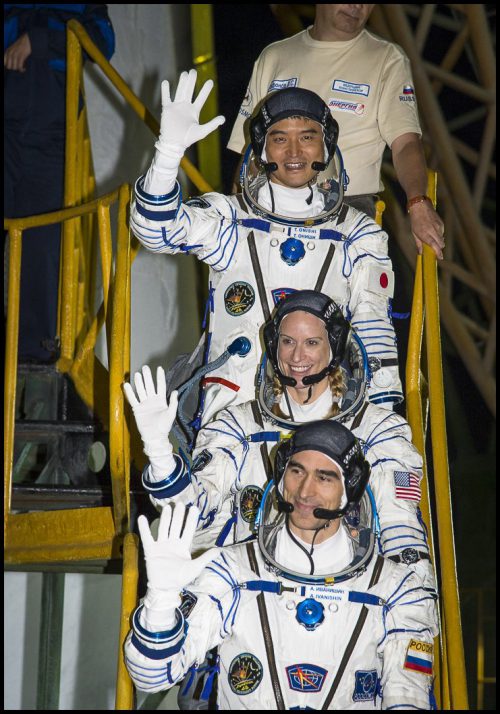
The Soyuz MS-01 crew (from bottom) Anatoli Ivanishin, Kate Rubins, and Takuya Onishi formed the second half of Expedition 48, before rotating into the core of Expedition 49. Photo Credit: NASA
Taking advantage of delays to Orbital ATK’s OA-5 Cygnus cargo mission, a “window” in the late August timeframe allowed NASA and its International Partners (IPs) to press ahead with a second EVA on 1 September. Williams and Rubins successfully retracted the Trailing Thermal Control Radiator (TTCR), which had been deployed back in 2012 to provide an interim cooling capability. Its retraction negates the risk of it suffering Micrometeoroid Orbital Debris (MMOD) damage and makes it available for possible future use. Returning inside after their two EVAs, Williams became the oldest U.S. spacewalker and Rubins now stands as the world’s sixth most experienced female spacewalker.
A few days later, on 6/7 September, Williams, Ovchinin, and Skripochka boarded their Soyuz TMA-20M spacecraft, undocked from the station, and touched down smoothly in Kazakhstan. Shortly before undocking, Williams handed command of the ISS over to Ivanishin and Expedition 49 officially got underway as soon as Soyuz TMA-20M undocked. This was expected to leave Ivanishin, Rubins, and Onishi as a reduced crew of three for a couple of weeks, before Soyuz MS-02 launched from Baikonur on 23/24 September, carrying Russian cosmonauts Sergei Ryzhikov and Andrei Borisenko, together with NASA astronaut Shane Kimbrough. However, a technical problem with the Soyuz MS-02 spacecraft forced a month-long delay, and Ryzhikov, Borisenko, and Kimbrough did not ultimately launch until 19 October. Following a 34-orbit rendezvous, they docked smoothly at the space-facing (or “zenith”) Poisk module on 21 October. And two days after that, Orbital ATK’s long-awaited OA-5 Cygnus cargo ship was successfully captured and berthed at the nadir port of the station’s Unity node.
Tomorrow (Friday), Ivanishin will ceremonially transfer command of the ISS from himself to Shane Kimbrough, thereby inaugurating Expedition 50, just a few days shy of the 16th anniversary since the first long-duration increment got underway on 2 November 2000. In marking 50 discrete expeditions, the ISS has greatly surpassed the 28 increments flown to the Mir space station between March 1986 and June 2000. Including Kimbrough’s increment, the ISS has seen 24 American and 23 Russian commanders, as well as one apiece from Europe, Canada, and Japan. Another European astronaut, Germany’s Alexander Gerst, will command the station in fall 2018.
Farewells between the six crew members will take place Friday, with hatch closure between Soyuz MS-01 and the Rassvet module expected to occur at 5:15 p.m. EDT. Ivanishin will assume the center commander’s seat for the return to Earth, flanked by Onishi in the left-side “Flight Engineer-1” couch and Rubins in the right-side “Flight Engineer-2” couch. They will spent the next several hours donning and leak-checking their Sokol (“Falcon”) launch and entry suits and readying the spacecraft for undocking. At 8:36 p.m. EDT, Ivanishin will command the hooks between Rassvet and the Soyuz to open, allowing springs to push them apart. Physical separation of the two space vehicles is scheduled about 90 seconds later, officially ending Expedition 49 and beginning Expedition 50.
Soyuz MS-01 will initially move away at a slowpoke pace of 0.4 feet (0.12 meters) per second, before Ivanishin executes an eight-second engine “burn” at 8:40 p.m. EDT. This will increase the departure rate to 1.74 feet (0.53 meters) per second, by which time the spacecraft will have reached approximately 50-65 feet (15-20 meters) from the orbital outpost. Moving further out, Soyuz MS-01 will fire its engines for 21 seconds at 8:46 p.m. EDT, further increasing the rate of departure to 5.3 feet (1.63 meters) per second.
Sunrise over the desolate Kazakh steppe will occur at 8:04 a.m. local time Saturday (10:04 p.m. EDT Friday), with an area about 87 miles (140 km) northwest of the remote town of Dzhezkazgan being targeted as the primary landing site. About an hour before touchdown, Russian Mi-8 recovery and rescue helicopters will take to the air from Dzhezkazgan. By this point, around 2.5 hours will have passed since Ivanishin, Rubins, and Onishi undocked from the space station. At 11:06:36 p.m. EDT Friday, Ivanishin will execute the “deorbit burn,” committing Soyuz MS-01 to a perilous and fiery descent back through Earth’s atmosphere. By this stage, the spacecraft will occupy an orbit of 267 miles (429.8 km). The burn will run for four minutes and 38 seconds and will dramatically slow the spacecraft by about 420 feet (128 meters) per second.
Shortly thereafter, the crew will be instructed to close their visors. Twenty-seven minutes after the deorbit burn, at 11:33 p.m. EDT, the spherical orbital module and cylindrical instrument module will be jettisoned, leaving the bell-shaped descent module alone against the furnace heat of re-entry. By this stage, Soyuz MS-01’s altitude will have dropped to 86.8 miles (139.8 km), with a little more than 25 minutes remaining before touchdown. At the landing site, it will be 9:33 a.m. on Saturday morning and the Mi-8 helicopters should be in position, flying an oval-shaped “racetrack” pattern, as they await the arrival of Ivanishin, Rubins, and Onishi. “Entry Interface”—the point at which the descent module begins to feel the brunt of thermal stress—will occur at 11:36:34 p.m. EDT, at an altitude of 327,756 feet, or 62 miles (100 km).
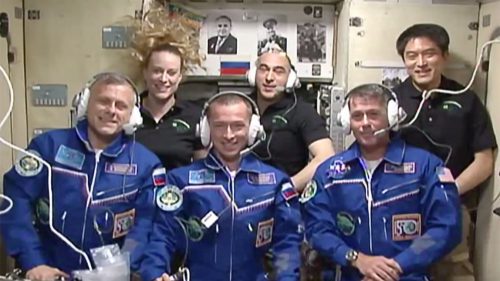
The six-strong Expedition 49 crew gathers to speak to media, family and well-wishers after hatch opening on 21 October. From left to right are Andrei Borisenko, Kate Rubins, Sergei Ryzhikov, Anatoli Ivanishin, Shane Kimbrough, and Takuya Onishi. Photo Credit: NASA
After passing through the worst of re-entry heating at about 11:42:55 p.m. EDT, Soyuz MS-01 will emerge from plasma at an altitude of 109,580 feet, or 20.7 miles (33.4 km). Its twin pilot parachutes will be deployed at 6.6 miles (10.7 km), followed by the 258-square-foot (24-square-meter) drogue and, finally, the 10,764-square-foot (1,000-square-meter) main canopy. Recovery forces will confirm the successful parachute deployments and will establish voice communications with the crew, as Soyuz MS-01 heads toward the Central Asian steppe. The main canopy will slow the spacecraft’s descent rate to 23.6 feet (7.2 meters) per second and its harnesses will first orient the Soyuz at a 30-degree angle to expel heat, before shifting it to a straight-vertical final descent.
Although slowed significantly, this is still not enough for a safe landing. Two seconds and just 2.6 feet (0.8 meters) before hitting the ground, six solid-fueled rockets in the descent module’s base will ignite to reduce the descent rate to just 5 feet (1.5 meters) per second. Touchdown of Soyuz MS-01 at co-ordinates 47.18 degrees North latitude and 69.35 degrees East longitude is scheduled for 11:59:50 p.m. EDT Friday (9:59:50 a.m. local time Saturday), about 3.5 hours after departing the ISS. Ivanishin, Rubins, and Onishi will be home after a remarkable expedition which will have lasted 115 days, 2 hours, and 22 minutes.
When one counts a handful of shorter increments in the 2008-2009 timeframe—by European astronaut Leopold Eyharts and NASA flyers Garrett Reisman, Tim Kopra, and Nicole Stott—the flight of Ivanishin, Rubins, and Onishi represents the fifth-shortest expedition in ISS Program history. However, since Eyharts, Reisman, Kopra, and Stott flew for only part of a longer expedition, Ivanishin’s crew actually sits in first place for the shortest single increment ever undertaken aboard the ISS. Initially scheduled to launch on 20/21 May 2016, they were delayed for operational and technical reasons into the late June and eventually early July. At the same time, their return date at the end of October remained unchanged, thus shortening their original 160-day mission by around 30 percent.
Quelle: AS
---
Russian military pilots to meet returning Soyuz-MS spacecraft crew in Kazakhstan
The search and rescue team comprises around 200 military servicemen, fourteen Mi-8 helicopters, Antonov An-12 and An-26 aircraft as well as search-and-evacuate amphibious aircraft
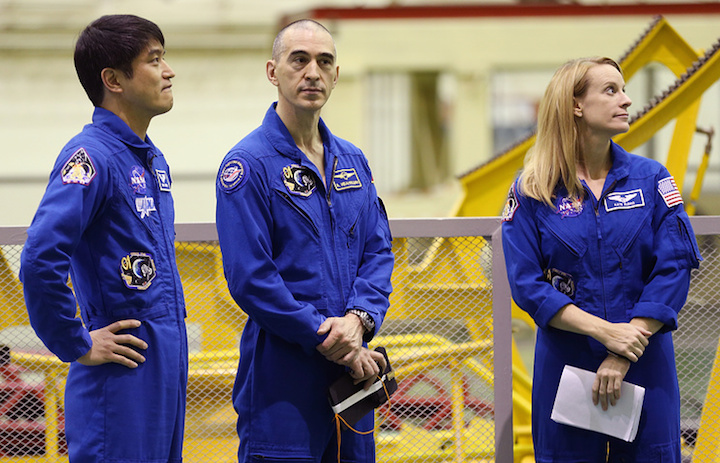
.
"Military aircraft has been redeployed from the Urals region to 4 air fields in Kazakhstan to meet the international crew of the manned "Soyuz-MS" spacecraft scheduled to land on Sunday, October 30. The pilots will locate the space capsule, conduct a medical examination of the cosmonauts and evacuate them from the landing site together with the space capsule," Roshchupkin elaborated.
According to him, the search and rescue team comprises around 200 military servicemen, fourteen Mi-8 helicopters, Antonov An-12 and An-26 aircraft and 20 other planesincluding four search-and-evacuate amphibious aircraft.
The International Space Station Expedition consisting of 49 crew members, Russia’s Anatoly Ivanshin, Japan’s Takuya Onishi and Kathleen Rubins from the US will return to the Earth on Sunday.
A lookout command post to meet the space capsule has been set up at the Combat Control Center of the 14th Air Force and Air Defense Army in the Urals’ city of Yekaterinburg.
Quelle: TASS
-
Update:
NASA Astronaut Kate Rubins Prepares For the Journey Home
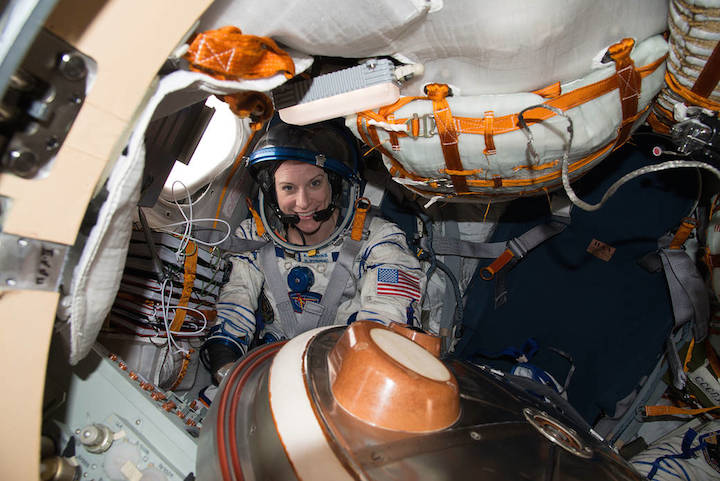
NASA astronaut Kate Rubins is pictured inside of the Soyuz MS-01 spacecraft while conducting routine spacesuit checks. Rubins, suited up in a Russian Sokol Launch and Entry suit, was conducting leak checks in advance of her upcoming landing along with Japan Aerospace Exploration Agency astronaut Takuya Onishi and cosmonaut Anatoly Ivanishin of the Russian space agency Roscosmos. The trio are scheduled to undock their Soyuz spacecraft from the space station at 8:37 p.m. EDT Saturday, Oct. 29, 2016, and land in Kazakhstan at 11:59 p.m. (9:59 a.m. Oct. 30, Kazakhstan time).
Their return will wrap up 115 days in space for the crew since their launch in July. Together, the Expedition 49 crew members pursued hundreds of experiments in biology, biotechnology, physical science and Earth science aboard the orbiting laboratory.
Quelle: NASA
-
Update: 29.10.2016
.
Three crew members on the International Space Station are scheduled to depart the orbital outpost Saturday, Oct. 29, with coverage of activities beginning the day before on NASA Television and the agency’s website.
Expedition 49 Commander Anatoly Ivanishin of the Russian space agency Roscosmos, and Flight Engineers Kate Rubins of NASA and Takuya Onishi of the Japan Aerospace Exploration Agency, will undock their Soyuz spacecraft from the space station at 8:37 p.m. EDT Saturday and land in Kazakhstan at 11:59 p.m. (9:59 a.m. Oct. 30, Kazakhstan time).
Their return will wrap up 115 days in space for the crew since their launch in July.
Together, the Expedition 49 crew members pursued hundreds of experiments in biology, biotechnology, physical science and Earth science aboard the orbiting laboratory.
NASA Television will air coverage of the departure and landing activities at the following dates and times:
Friday, Oct. 28:
- 3:30 p.m. – Change of command ceremony in which Ivanishin hands over station command to NASA’s Shane Kimbrough
Saturday, Oct. 29:
- 4:45 p.m. – Farewell and hatch closure coverage (hatch closure scheduled at 5:15 p.m.)
- 8:15 p.m. – Undocking coverage (undocking scheduled at 8:37 p.m.)
- 10:45 p.m. – Deorbit burn and landing coverage (deorbit burn scheduled at 11:06 p.m., with landing at 11:59 p.m.)
Sunday, Oct. 30:
- 2 a.m. – Video File of hatch closure, undocking and landing activities
- 1 p.m. – Video File of landing and post-landing activities and post-landing interview with Rubins and Onishi in Kazakhstan
At the time of undocking, Expedition 50 will begin aboard the station under the command of NASA astronaut Shane Kimbrough. Along with his crewmates Sergey Ryzhikov and Andrey Borisenko of Roscosmos, the three-person crew will operate the station for three weeks until the arrival of three new crew members. Peggy Whitson of NASA, Thomas Pesquet of ESA (European Space Agency) and Oleg Novitsky of Roscosmos are scheduled to launch in November from Baikonur, Kazakhstan.
Quelle: NASA
-
Update: 30.10.2016
.
Expedition 49 Soyuz Spacecraft Landing
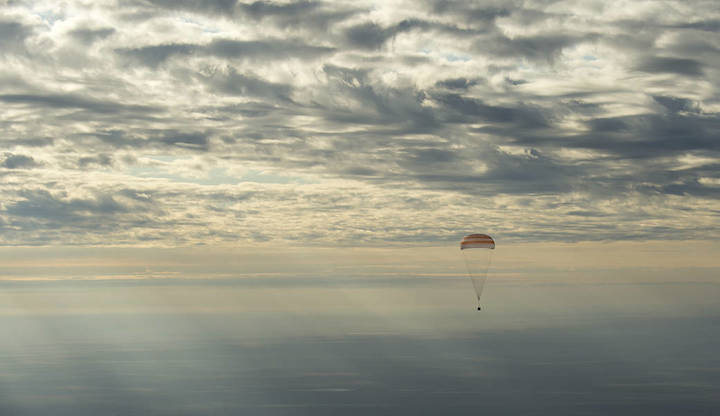
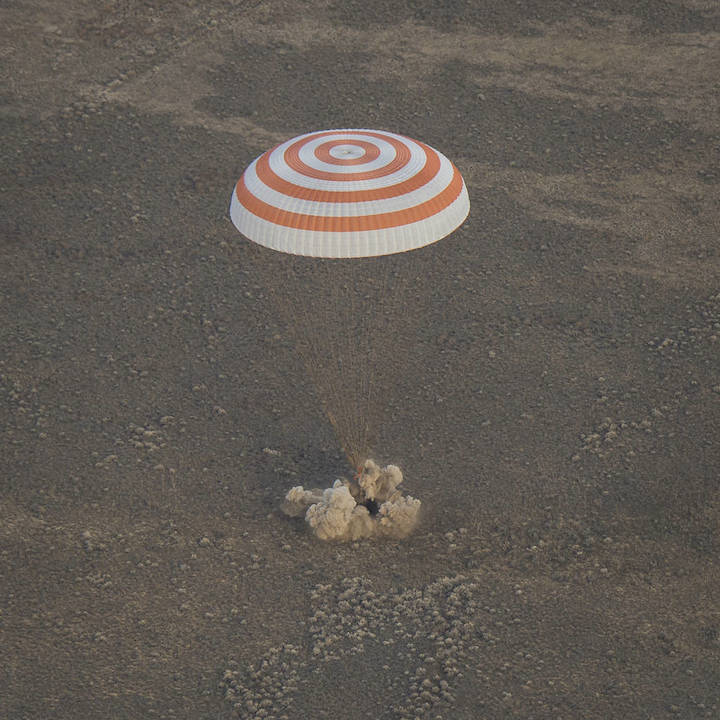
The Soyuz MS-01 spacecraft is seen as it lands with Expedition 49 crew members NASA astronaut Kate Rubins, Russian cosmonaut Anatoly Ivanishin of Roscosmos, and astronaut Takuya Onishi of the Japan Aerospace Exploration Agency (JAXA) near the town of Zhezkazgan, Kazakhstan on Sunday, Oct. 30, 2016 (Kazakh time). Rubins, Ivanishin, and Onishi are returning after 115 days in space where they served as members of the Expedition 48 and 49 crews onboard the International Space Station.
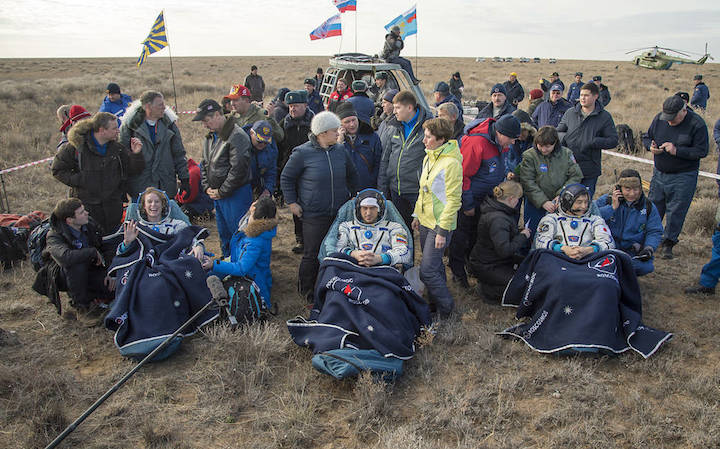
NASA astronaut Kate Rubins, left, Russian cosmonaut Anatoly Ivanishin of Roscosmos, center, and astronaut Takuya Onishi of the Japan Aerospace Exploration Agency (JAXA) sit in chairs outside the Soyuz MS-01 spacecraft a few moments after they landed in a remote area near the town of Zhezkazgan, Kazakhstan on Sunday, Oct. 30, 2016 (Kazakh time). Rubins, Ivanishin, and Onishi are returning after 115 days in space where they served as members of the Expedition 48 and 49 crews onboard the International Space Station.
NASA astronaut and Expedition 49 crew member Kate Rubins, who became the first person to sequence DNA in space, returned to Earth Saturday after a successful mission aboard the International Space Station.
Rubins and her crewmates Anatoly Ivanishin of the Russian space agency Roscosmos and Takuya Onishi of the Japan Aerospace Exploration Agency, touched down in their Soyuz MS-01 at 11:58 p.m. EDT (9:58 a.m. Oct. 30, Kazakhstan time) southeast of the remote town of Dzhezkazgan in Kazakhstan.
Rubins, who has a degree in molecular biology, contributed to several new studies taking place for the first time aboard the space station, including the Biomolecule Sequencer experiment. The ability to sequence the DNA of living organisms in space could enable astronauts to diagnose an illness, or identify microbes growing in the space station and determine whether they represent a health threat.
During her time on the orbiting complex, Rubins ventured outside the confines of the station for two spacewalks. During the first one on Aug. 19, she and NASA astronaut Jeff Williams installed the first international docking adapter. Outfitted with a host of sensors and systems, the adapter’s main purpose is to provide a port for spacecraft bringing astronauts to the station in the future. Its first users are expected to be the Boeing Starliner and SpaceX Crew Dragon spacecraft now in development in partnership with NASA's Commercial Crew Program. During her second spacewalk Sept. 1, Rubins and Williams retracted a spare thermal control radiator and installed two new high-definition cameras.
Together, the Expedition 49 crew members contributed to hundreds of experiments in biology, biotechnology, physical science and Earth science aboard the world-class orbiting laboratory during their 115 days in space.
The trio also welcomed three cargo spacecraft delivering several tons of supplies and research experiments. Rubins was involved in the grapple of Orbital ATK’s Cygnus spacecraft to the station in October, the company's sixth contracted commercial resupply mission, and SpaceX’s Dragon ninth contracted mission in July. One Russian ISS Progress cargo spacecraft also docked to the station in July.
Rubins and Onishi have each spent a total of 115 days in space during their first mission. Ivanishin now has 280 days in space from two flights.
Expedition 50, with Shane Kimbrough of NASA in command and his crewmates Sergey Ryzhikov and Andrey Borisenko of Roscosmos, will operate the station for three weeks until the arrival of three new crew members.
Peggy Whitson of NASA, Thomas Pesquet of ESA (European Space Agency) and Oleg Novitskiy of Roscosmos are scheduled to launch Nov. 17 from Baikonur, Kazakhstan.
Quelle: NASA
----
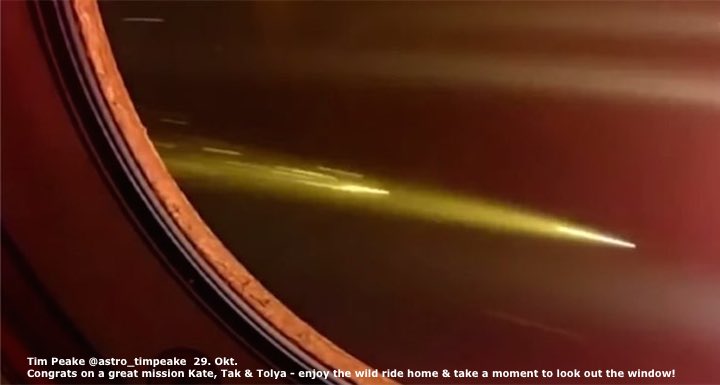
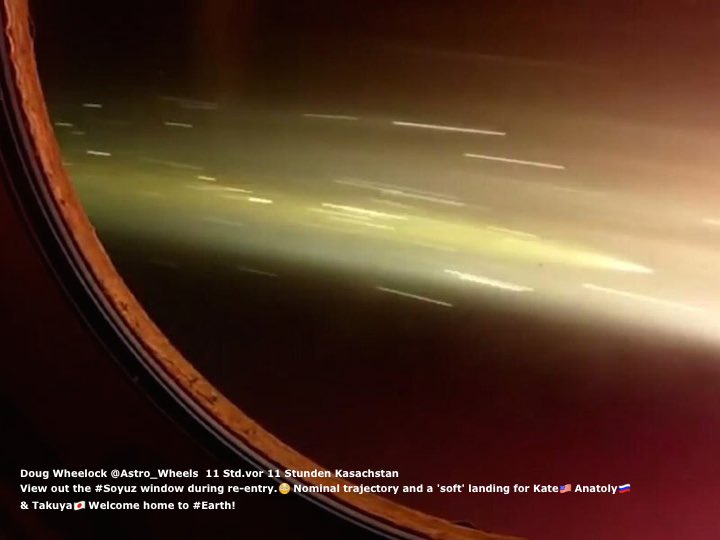
Quelle: NASA
---
Return of the Soyuz Spacecraft (47S/MS-01) with Astronaut Takuya Onishi aboard
October 30, 2016 (JST)
National Research and Development Agency
Japan Aerospace Exploration Agency (JAXA)
The Soyuz spacecraft (47S/MS-01) has safely returned to Earth with astronaut Takuya Onishi aboard who completed his long-duration mission on the International Space Station (ISS).
| Landing Date/Time: | 12:58, October 30 2016 (JST) 9:58, October 30 2016 (Kazakhstan Time) |
|---|---|
| Landing Location: | Republic of Kazakhstan |
| Crewmembers: | Anatoly Ivanishin (ROSCOSMOS) Takuya Onishi (JAXA) Kathleen Rubins (NASA) |
| Note 1: | The 48th and 49th expedition crews (Astronauts Ivanishin, Onishi, and Rubins) stayed in space for 115 days (2 days from launch to ISS ; 113 days at ISS). |
|---|---|
| Reference links for further information: |
|
Comments by JAXA President
on Return of the Soyuz Spacecraft (47S/MS-01) with Astronaut Onishi aboard
I, Naoki Okumura, President of JAXA, am pleased with the safe return of the Soyuz Spacecraft with Astronaut Onishi aboard, which landed in the Republic of Kazakhstan today, following the Astronaut’s long-term stay at the International Space Station.
Japanese technology has proved to be the backbone of his mission. Astronaut Onishi took over the effective research environment that his forerunner Astronaut Kimiya Yui prepared and has successfully accomplished the mission.
It includes the experiment of breeding mice simultaneously in a microgravity and modified gravity (1G) environment, and bringing them back to Earth all alive, which is an unprecedented success. The accomplishments of the experiment are expected to be applied in the medical field: to remedy the mass decrease of bones and muscles at an accelerated speed that astronauts suffer in space, which hopefully in the future may be applied to treat patients of aging-related illnesses, such as osteoporosis and amyotrophia, similar to fast loss of musculature in zero gravity.
Onishi’s mission also illustrated ways to broaden the scope of space environment utilization through enabling remote control of the Japanese experiment module ‘KIBO’ airlock and deployment of CubeSats from ground with the use of ‘KIBO’ robotic arm. Japan, being the only country in Asia participating in the ISS project, the experiments Onishi conducted have great educational value for the growth of members in neighboring Asian countries. Through this opportunity, space exploration agencies of other Asian countries have shown interest in further utilization of ‘KIBO’.
In addition, the comprehensive strength of “Team Japan” was proven throughout his stay at the ISS. Together with the ground control team in Tsukuba, Onishi contributed to the capture of the U.S. Cygnus cargo spacecraft which uses the same rendezvous system as JAXA’s KOUNOTORI (H-II Transfer Vehicle, HTV).
Onishi’s mission clearly demonstrated that Japan is an essential partner of the ISS project. After his return to Earth, Onishi, through his experience in space, will contribute to produce the outcome of ‘KIBO’ utilization and to further improve the development of Japan’s manned space technology. His experience will be passed onto Astronaut Norishige Kanai, who is now preparing for his flight in 2017.
I express my heartfelt gratitude to the fellow Japanese, pertinent Japanese parties, NASA, and Roscosmos for their support on behalf of the successful completion of Onishi’s mission.
Thank you.
Quelle: JAXA


